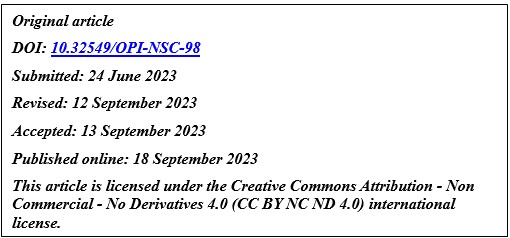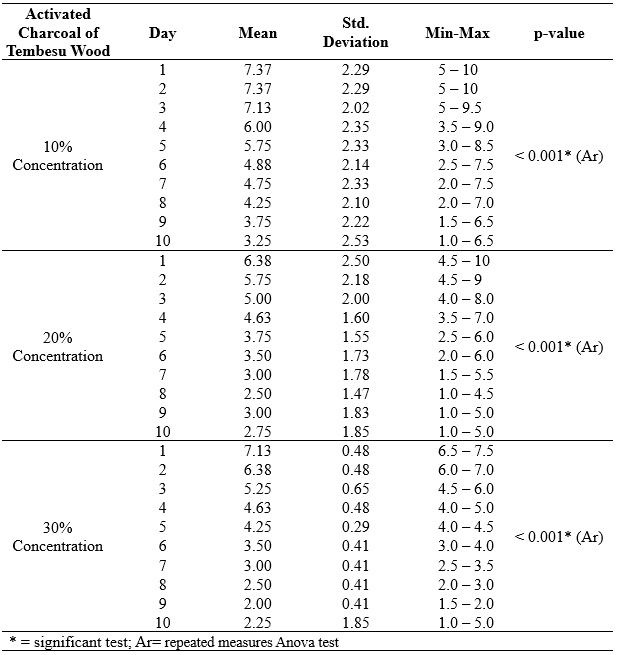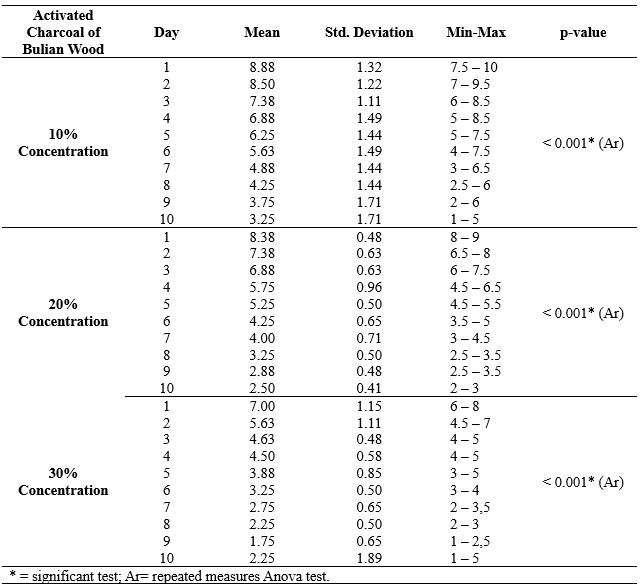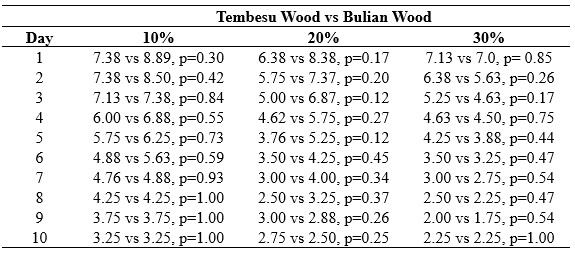Rina Kurnianti1, Retno Dwi Sari1, Mira Sri Gumilar1*
1Department of Dental Health, Health Polytechnic of Jambi, Indonesia
* Corresponding author: Mira Sri Gumilar, Jl. KH. Agus Salim no. 9 Kota Baru Jambi city, 36128, Indonesia, ORCID: https://orcid.org/0000-0002-0029-3099
Email: gumilarmirasri@gmail.com
Phone: +6281223339230

Cite this article
ABSTRACT
Introduction: Discoloration of the teeth can occur when stains damage the surface of tooth enamel. Developing treatment of teeth discoloration has increasingly due to discoloration teeth. Activated wood charcoal is one of the natural ingredients that can be used as an alternative to chemical home-use bleaching.
Objective: The purpose of this study was to obtain the effectiveness of activated charcoal made from tembesu wood and bulian wood for home-use bleaching teeth
Materials and Methods: This experiment was conducted at two locations: the Jambi Health Polytechnic Pharmacy Laboratory and the Jambi University Laboratory. It involved 60 samples, which were divided into six groups. The samples used in this research consisted of individuals with missing permanent teeth. The tooth color was assessed using the Vita Classical Shade Guide Tool. Charcoal derived from bulian wood and tembesu wood was mixed with toothpaste at concentrations of 10%, 20%, and 30%.
Results: Our results showed a significant teeth whitening in both groups, namely Tembesu wood and Bulian. Particularly, we found that Tembesu wood, when used at concentrations of 10%, 20%, and 30%, is highly effective in teeth whitening. Specifically, at a 10% concentration of Tembesu wood, teeth whitening displayed a notable increase from day four to day 10. Meanwhile, at concentrations of 20% and 30%, teeth whitening exhibited significant improvement from day two to 10. In the case of Bulian Wood, teeth whitening was similarly effective for concentrations of 10% and 20%, with noticeable enhancement from day two to 10. For the 30% concentration, teeth whitening effectiveness increased substantially, starting from day one and continuing through day 10. Finally, no statistically significant difference between the two groups was found (p>0.05).
Discussion: Tembesu wood and bulian wood at concentrations of 10%, 20%, and 30% are effectively used for teeth whitening, and there is no statistically significant difference between the two groups (p > 0.05).
Keywords: Activated charcoal, Bleaching teeth, Tooth whitening, Whitening toothpaste
INTRODUCTION
Tin-Oo MM et al [1] study performed in Malaysia showed that most of the participants were not satisfied with the color of their teeth, and need to use substance in whitening for their teeth. Healthy white color teeth make people more confident with their appearance. This reason encourages the desire for dental services, especially in aesthetic dentistry. Developing treatment of teeth discoloration has increasingly due to discoloration teeth. This condition drives a concern among patients and clinicians to improve dental aesthetics services.
Discoloration of the teeth can occur when stains damage the surface of tooth enamel [2]. The natural color of the teeth is polychromatic which differs in each third of the tooth based on the thickness and translucency of the enamel and dentin depending on the degree of calcification [3]. The natural color of teeth is bluish white in primary teeth and grayish yellow, grayish white or yellowish white in permanent teeth [4]. Changes in the natural color of the teeth differ according to their etiology and severity. It can be classified into extrinsic and intrinsic discoloration [4].
Tooth discoloration can be treated in several ways according to the diagnosis [5]. The treatment that is commonly conducted is chemical bleaching techniques. In this treatment oxidizing material can be used as a bleaching procedure to whiten the color of teeth by applying chemicals such as hydrogen peroxide and carbamide peroxide. The use of these chemicals has side effects such as hypersensitivity, cervical resorption, and external roots on teeth.
Numerous studies have indicated that incorporating light with bleaching gels does not result in significant improvements in the effectiveness of whitening procedures [6,7]. A recent systematic review and meta-analysis found that the use of light to activate the bleaching agent did not lead to better efficiency when compared to bleaching methods without light [8].
Activated wood charcoal is one of the natural ingredients that can be used as an alternative to chemical home-use bleaching because it has a high absorption effect on stains. Activated charcoal is a carbon material that can be produced from various raw materials containing carbon. One of the raw materials that can be used for activated charcoal is wood charcoal. Activated charcoal has been widely used as an absorbent for gas purification, water purification and oil purification due to its excellent absorption properties.
Jambi has commodity of Tembesu wood and Bulian wood as a timber forest product. The eminence quality of Tembesu wood and Bulian wood are characterized by its density. Now, utilization of these woods is still for the furniture or material house building. With this study we hope this commodity can be used for dental health. Activated charcoal can be used as a material for toothpaste, teeth whitening gel and others. This study can be a potential factor to develop dental health material product with local wisdom. Accordingly, the purpose of this study was to obtain the effectiveness of activated charcoal made from Tembesu wood and activated charcoal made from Bulian wood for home-use bleaching teeth.
MATERIALS AND METHODS
This research method was experimental research that was carried out in the Pharmacy Laboratory of Health Polytechnic of Jambi and in the laboratory of the Faculty of Engineering, University of Jambi. This study involved six groups of treatment that each group consisted of ten samples.
The samples of this study were permanent lost teeth, which were taken from the dental health clinic of Department Dental Health, Health Polytechnic of Jambi. The criteria for the teeth used in this study were permanent maxillary right first incisors (11), permanent maxillary right second incisors (12), permanent maxillary left first incisors (21), and permanent maxillary left second incisors (22). The condition of the teeth must be free of caries and calculus. The teeth used in this study were dipped with a 50% solution of Arabica coffee for a duration of 6 hours a day. This treatment repeated for 10 days. Each tooth was placed in a different container and the coffee solution was changed daily. To isolate from the coffee, the teeth’s roots covered with clear nail polish. After 10 days of immersion, the teeth were removed and washed with saline and then dried. The purpose of dipping teeth to coffee was to discolor the teeth, so before treatment each tooth had the same color. The measurement of color on teeth used the Vita Classical Shade Guide Tool.
The material of activated charcoal for this study was from Bulian wood and Tembesu wood. Bulian wood and Tembesu wood were one of the forest product commodities in Jambi Province, Indonesia. This study will examine the ability of activated charcoal to whiten teeth in concentrations of 10%, 20%, and 30%.
Bulian wood and Tembesu wood were processed into charcoal at 400°C for 12 hours. After the wood has turned into charcoal, then the charcoal was ground and sieved using Retsch to get a size of 200 meshes. Furthermore, the charcoal was activated through physical activation by heating in a furnace for three hours at a temperature of 800°C. This process converted bulian wood and tembesu wood to be activated charcoal. Activated charcoal was left in a desiccator for 15 minutes.
The product of activated charcoal will be mixed with toothpaste at concentrations at 10%, 20%, and 30% both in Bulian and Tembesu wood. By this treatment, the study had six groups that were intervened. The intervention for each group consist of 10% bulian wood activated charcoal, 20% Bulian wood activated charcoal, 30% Bulian wood activated charcoal, 10% Tembesu wood activated charcoal, 20% Tembesu wood activated charcoal, and 30% Tembesu wood activated charcoal.
Treatment was done by applying toothpaste contain of activated charcoal in certain concentration to the tooth surface by brushing at a pressure of 300 to 400 N/m2 on all teeth. Tooth-brushing is done in small circular motions for 2 minutes, then allowed to stand for 10 minutes and then rinsed with running saline water. This treatment was repeated for 10 days. The data of score white tooth level measured by Vita Classical Shade Guide Tool.
Ethical considerations
This research was approved by ethics No. LB.02.06/2/98/2022 from Health Polytechnic of Jambi, Jambi Province, Indonesia.
Statistical analysis
Data were presented as numbers or percentages for categorical variables. Continuous data are expressed as the mean ± standard deviation (SD), or median with Interquartile Range (IQR). Prior to the statistical test, a data normality test was carried out using the Kolmogorov-Smirnov test which aims to assess the distribution of data in a group of data or variables, whether the data distribution is normally distributed or not. From normality test, the data had normal distribution, so the collected data analyzed using the repeated measures Anova test. If the Anova test for was significant (p<0.05) the post hoc Anova test was performed for pairwise comparison. Finally, to test the differences between Tembesu and Bulian wood, we used the independent t test.
We considered all tests with p<0.05 as significant. We analyzed all data using SPSS statistical software ver. 16.
RESULTS
The research results can be presented in the following table:

Table 1. Data normality test results
Table 1 shows that the p-value is >0.05, it means all variables are normally distributed, thus the statistical test used is the parametric test.

Table 2. The Results of the repeated measures Anova test for Tembesu Wood Activated Charcoal Group at 10%, 20% and 30% of concentration.
The table illustrates that the results of the tests were less than 0.001, indicating the effective utilization of tembesu wood at concentrations of 10%, 20%, and 30% for teeth whitening between 1 and 10 days of use. Specifically, by post hoc Anova test we found for the 10% concentration of tembesu wood, a noticeable enhancement in teeth whitening effectiveness from day four to day 10. Similarly, for tembesu wood concentrations of 20% and 30%, there was a significant improvement in teeth whitening efficacy from day two to day 10 (p<0.05).

Table 3. The Results of the repeated measures Anova test for Bulian Wood Activated Charcoal Group at 10%, 20% and 30% of concentration.
The table shows that the results of the statistical tests were less than 0.05, indicating that bulian wood, when used at concentrations of 10%, 20%, and 30%, is highly effective for teeth whitening between 1 and 10 days of use. In the case of tembesu wood, by post hoc Anova test at concentrations of 10% and 20%, we found an improvement in teeth whitening effectiveness from day two to day 10. Conversely, at a concentration of 30%, teeth whitening exhibited a significant increase in effectiveness, starting from day one and extending through day 10.
In table 4, we reported the comparison between Tembesu Wood and Bulian Wood group, for each day at 10%, 20% and 30% of concentration.

Table 4. Comparison between Activated Charcoal of Bulian Wood and Activated Charcoal of Tembesu Wood, to identify for each concentration (10%, 20%, 30%).
Table 4 shows that there is no statistically significant difference between tembesu wood and bulian wood when used at concentrations of 10%, 20%, and 30% over the course of the first ten days, as indicated by a p-value > 0.05.
DISCUSSION
Five groups in this study shown that activated charcoal could decrease the level color tooth score which was if its level decreased so the tooth was whiter. The group with the 10% concentration activated charcoal of Tembesu wood could not effectively decreased the color tooth score in ten days.
Tembesu wood and bulian wood had a different minimum effectiveness concentration and duration of use activated charcoal toothpaste. Tembesu wood was effective minimum concentration for bleaching teeth at 20% concentration. In this concentration, need 8 days to whitening the teeth. 30% Activated charcoal of Tembesu wood could whiten the teeth in two days.
Bulian wood had minimum concentration that can decrease the color tooth score at 10% concentration in eighth days. If we were using 20% concentration and 30% concentration, the effectiveness of bleaching teeth could reach in three days. The other study shown that activated charcoal toothpaste can remove stain from resin composite.
Activated charcoal is a porous solid containing 85-95% carbon, produced from carbon-containing materials such as hardwood trees and coconut shells. In medicine, activated carbon has been used for ‘universal antidote’ in cases of poisonings, as a filter aid agent, and in decolorization processes [9,10]. This advantage of activated charcoal is from their adsorptive ability. Activated wood charcoal is one of the natural ingredients that can be used as an alternative to chemical home bleaching because it has a high absorption effect on stains [11,12].
Bulian wood and Tembesu wood are wood that is widely available in Jambi Province. The eminence quality of Tembesu wood and Bulian wood are characterized by the dense of their wood. Now, utilization of that wood is still for the furniture or material house building[13]. With this study we hope this commodity can be use for dental health. Activated charcoal can using as a material for whitening toothpaste, teeth whitening gel and others. With this innovation, it can be a potential factor to develop dental health material with local wisdom [14].
Activated charcoal is a broad-spectrum agent that effectively binds to many pollutant compounds like organic, inorganic, biological and microbial. The efficiency of absorption from these substances is influenced by various factors such as pH, ionic strength of saliva, dispersion time, modification procedure, physical properties include surface area and porosity and chemical properties of activated charcoal. The advantage of activated charcoal is that it has a strong binding capacity so that when applied to the tooth surface, a significant change in the color of tooth enamel will be obtained [11,15,16].
The chemical bleaching teeth usually used carbamide peroxide, which is a combination of hydrogen peroxide and urea. The use of these chemicals has side effects such as hypersensitivity, cervical resorption, and external roots on teeth [17,18]. Another advantage is that there is no limit to consumption. When swallowed up to 100 grams will not cause any side effects. This is because activated charcoal is not absorbed by the body, but activated charcoal absorbs all dirt, oil, toxins in the digestive tract, toxins in the body, so activated charcoal is proven to be safe when it is in the mouth and in contact with the teeth within 5 minutes to perform a tooth whitening procedure [19,20].
The most important property of activated charcoal is absorption. In this case, there are several factors that affect the adsorption capacity such as porous solid, which mostly consists of free carbon elements, and each is covalently bonded. Thus, the activated charcoal surface is non-polar. In addition to composition and polarity, pore structure is also an important factor to consider. The pore structure is related to the surface area, the smaller the pores of the activated charcoal, the larger the surface area. Thus, the adsorption speed increases. To increase the adsorption speed, it is recommended to use activated charcoal that has been pulverized. The amount or dose of activated charcoal used, is also considered [21–23].
Except for whitening the teeth, brushing teeth with activated charcoal can reduce plaque. Based on the data of 2013 National Health Research reported peoples in Indonesia have a good behavior of brushing teeth with proportion was 93.8%, but its correctly was very poor that only 2.3% [24]. In this situation, the good appearance of teeth must be followed by the health of teeth. Because the good condition of teeth is good color and be spared from the diseases like caries. Good condition of teeth is dependent on people’s behaviour.
CONCLUSION
Dental nurses can actively fulfill their role in providing oral health education to effectively maintain dental health by utilizing natural materials rooted in local wisdom, such as Tembesu and Bulian wood. It is crucial for the public to recognize the significance of dental health improvement, as it is closely intertwined with one’s quality of life. Healthy teeth contribute to self-confidence and alleviate discomfort for both individuals and those around them. Dental nurses must persuade the public that attaining good dental health is attainable at a minimal cost and through straightforward methods of preparing the materials. Additionally, these research findings can serve as a foundation for the development of packaged toothpaste derived from Tembesu and Bulian wood by dental nurses.
In this study was observed that, both tembesu and bulian wood, when utilized at concentrations of 10%, 20%, and 30%, proved effective for teeth whitening, while no significant differences were observed between the two treatments (p > 0.05).
Study limitation
The limitation of this study lies in the relatively small number of samples.
Funding statement
This research did not receive any specific grant from funding agencies in the public, commercial, or not for profit sectors.
Conflict of interest
The authors report no conflict of interest.
Authors’ contribution
RIK, RDS and MSG carried out initial observations, defined problems, and conceptualized research topics, RDS, MSG developed research instruments, and collected data in the field, RIK analyzed data. RIK, MSG compiled the manuscript. All authors finalized the manuscript and approved it.
Acknowledgements
The author would like to thank all the staff of the dental health clinic of Department Dental Health, Health Polytechnic of Jambi who were involved in this research. Also to the President of Health Polytecnic of Jambi who has given permission for this research.
REFERENCES
- Tin-Oo MM, Saddki N, Hassan N. Factors influencing patient satisfaction with dental appearance and treatments they desire to improve aesthetics. BMC oral health. 2011;11(1):1–8.
- Dalrymple A, Bean E-J, Badrock TC, Weidman RA, Thissen J, Coburn S, et al. Enamel staining with e-cigarettes, tobacco heating products and modern oral nicotine products compared with cigarettes and snus: An in vitro study. Am J Dent. 2021;34(1):3–9.
- Chen H, Liu Y. Teeth. In: Advanced ceramics for dentistry. Elsevier; 2014. p. 5–21.
- Mortazavi H, Baharvand M, Khodadoustan A. Colors In Tooth Discoloration: A New Classification And Literature Review. International Journal of Clinical Dentistry. 2014;7(1).
- Rodríguez‐Martínez J, Valiente M, Sánchez‐Martín M. Tooth whitening: From the established treatments to novel approaches to prevent side effects. Journal of Esthetic and Restorative Dentistry. 2019;31(5):431–40.
- Gonçalves RS, Costa CAS, Soares DGS, Santos PH dos, Cintra LTA, Briso ALF. Effect of different light sources and enamel preconditioning on color change, H2O2 penetration, and cytotoxicity in bleached teeth. Operative dentistry. 2016;41(1):83–92.
- Maran BM, Burey A, de Paris Matos T, Loguercio AD, Reis A. In-office dental bleaching with light vs. without light: A systematic review and meta-analysis. Journal of dentistry. 2018;70:1–13.
- Maran BM, Ziegelmann PK, Burey A, de Paris Matos T, Loguercio AD, Reis A. Different light-activation systems associated with dental bleaching: a systematic review and a network meta-analysis. Clinical oral investigations. 2019;23:1499–512.
- Thakur A, Ganeshpurkar A, Jaiswal A. Charcoal in dentistry. Natural Oral Care in Dental Therapy. 2020;197–209.
- Oremosu OA, Umesi DC, Oderinu OH, Banjo SA. Dental implants as tooth replacement option among patients in government hospitals Lagos, South-West Nigeria. European Journal of Prosthodontics. 2016;4(1):7.
- Viana ÍEL, Weiss GS, Sakae LO, Niemeyer SH, Borges AB, Scaramucci T. Activated charcoal toothpastes do not increase erosive tooth wear. Journal of dentistry. 2021;109:103677.
- Epple M, Meyer F, Enax J. A critical review of modern concepts for teeth whitening. Dentistry journal. 2019;7(3):79.
- Ismail I, Habriyanto H, Badaruddin B. Strategi Pemenuhan Kelangkaan Bahan Baku Industri Kecil Mebel Kayu di Kecamatan Jambi Luar Kota Kabupaten Muaro Jambi. UIN Sulthan Thaha Saifuddin Jambi; 2021.
- Tomás DBM, Pecci-Lloret MP, Guerrero-Gironés J. Effectiveness and Abrasiveness of Activated Charcoal As A Whitening Agent: A Systematic Review of In Vitro Studies. Annals of Anatomy-Anatomischer Anzeiger. 2022;151998.
- Lestari U, Syamsurizal S, Trisna Y. The Antiplaque Efficacy and Effectiveness of Activated Charcoal Toothpaste of Elaeis guineensis in Smokers. Indonesian Journal of Pharmaceutical Science and Technology. 2021;1:75–87.
- Agrawal P, Panda S, Mishra SR. A Review On Activated Charcoal Tooth Paste. World Journal of Pharmaceutical Research. 2018;7(9):478-481.
- Siregar. Efektivitas Penggunaan Pasta Gigi Arang Aktif (Activated Charcoal) Terhadap Perubahan Warna Gigi Pada Masyarakat Kampung Belawan Bahagia Kecamatan Medan Belawan Tahun 2020. 2020;
- Ameli N, Kianvash Rad N, Nikpour F, Ghorbani R, Mohebi S. Effect of Short-and Long-term Use of Home and In-Office Bleaching with Carbamide Peroxide and Hydrogen Peroxide on Enamel Microhardness. Journal of Dentistry Indonesia. 2020;27(2):50–5.
- Alshamsi ZAN, Walke S. Utilization of Food Waste For Production of Activated Carbon. International Journal of Electrical Engineering and Technology (IJEET). 2021;12(7):88–95.
- Ajayi DM, Gbadebo SO, Adebayo GE. Perception about tooth colour and appearance among patients seen in a tertiary hospital, South-West, Nigeria. The Pan African Medical Journal. 2021;38.
- Zellner T, Prasa D, Färber E, Hoffmann-Walbeck P, Genser D, Eyer F. The use of activated charcoal to treat intoxications. Deutsches Aerzteblatt International. 2019;116(18):311.
- Toxicology AA of C, Toxicologists EA of PC and C. Position paper: single-dose activated charcoal. Clinical Toxicology. 2005;43(2):61–87.
- Mohammad-Khah A, Ansari R. Activated charcoal: preparation, characterization and applications: a review article. Int J Chem Tech Res. 2009;1(4):859–64.
- Kementrian Kesehatan RI. Laporan Nasional hasil Riskesdas 2013 [Internet]. Jakarta: Badan Penelitian dan Pengembangan kesehatan; 2013. Available from: https://pusdatin.kemkes.go.id/resources/download/general/Hasil Riskesdas 2013.pdf.Last accessed: 1 June 2022.
![]() This work is licensed under a Creative Commons Attribution-NonCommercial-NoDerivatives 4.0 International License.
This work is licensed under a Creative Commons Attribution-NonCommercial-NoDerivatives 4.0 International License.
